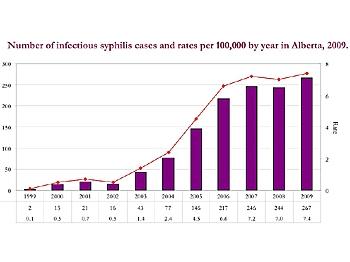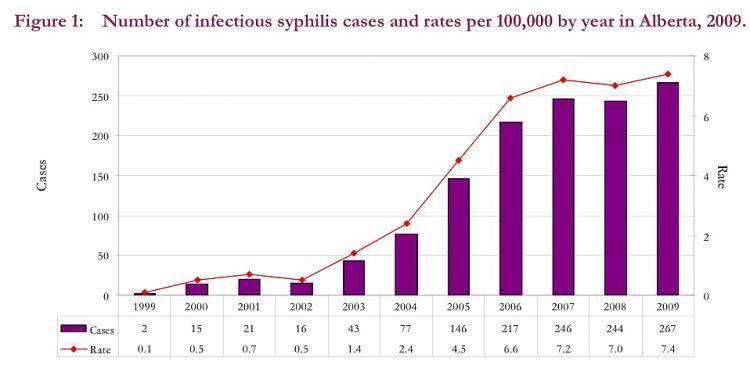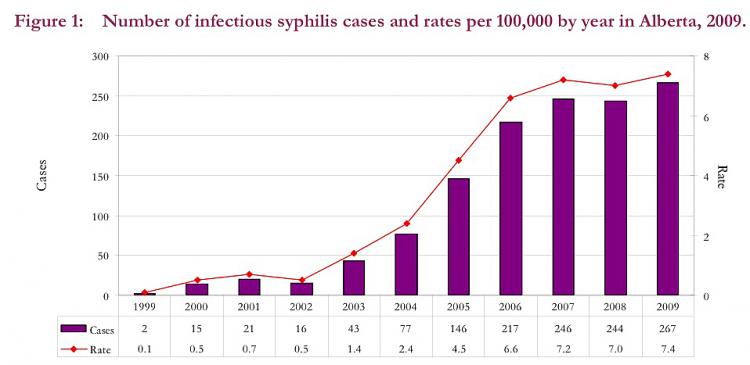EDMONTON—Alberta is continuing to see high cases of syphilis—including in babies and the elderly, according to a report published by Alberta Health and Wellness last week.
“We have a Problem,” begins the report, prepared by the Office of the Chief Medical Officer of Health. It says the number of cases of the sexually transmitted infection have increased dramatically since 2000.
“The urgent need to interrupt this outbreak is compounded by the occurrence of babies being born with congenital syphilis, a situation that is completely preventable,” reads the report.
There were seven confirmed cases of infants born with congenital syphilis in Alberta in 2009, and another six infants are still under investigation, says the report. During the same year, there was only one case of congenital syphilis reported in other provinces.
Howard May, a spokesman with Alberta Health and Wellness (AHW), says the cause of the rising rates is not clear at this point, but complacency about safe sex is a contributing factor.
“The rising rates of syphilis and other sexually transmitted infections (STI) in Alberta are a serious concern,” he wrote in an email.
According to figures published by the Public Health Agency of Canada, the rate of infection per 100,000 people in Alberta was 7.3, higher than other provinces in Canada in 2009 (though lower than Yukon Territories and Northwest Territories), followed by Ontario with 5.4, and Quebec and British Columbia with 4.8 each.
The AHW report says the disease, which was most commonly found among homosexual men before 2000 and mostly seen in the large urban centres of Edmonton and Calgary, has now spread outside the high-risk groups and is being found in all segments of the population and throughout the entire province.
“The disease is being found in young children under one year of age; teenagers as young as 14; seniors as old as 84; university students and professionals,” the report says.
“We have a Problem,” begins the report, prepared by the Office of the Chief Medical Officer of Health. It says the number of cases of the sexually transmitted infection have increased dramatically since 2000.
“The urgent need to interrupt this outbreak is compounded by the occurrence of babies being born with congenital syphilis, a situation that is completely preventable,” reads the report.
There were seven confirmed cases of infants born with congenital syphilis in Alberta in 2009, and another six infants are still under investigation, says the report. During the same year, there was only one case of congenital syphilis reported in other provinces.
Howard May, a spokesman with Alberta Health and Wellness (AHW), says the cause of the rising rates is not clear at this point, but complacency about safe sex is a contributing factor.
“The rising rates of syphilis and other sexually transmitted infections (STI) in Alberta are a serious concern,” he wrote in an email.
According to figures published by the Public Health Agency of Canada, the rate of infection per 100,000 people in Alberta was 7.3, higher than other provinces in Canada in 2009 (though lower than Yukon Territories and Northwest Territories), followed by Ontario with 5.4, and Quebec and British Columbia with 4.8 each.
The AHW report says the disease, which was most commonly found among homosexual men before 2000 and mostly seen in the large urban centres of Edmonton and Calgary, has now spread outside the high-risk groups and is being found in all segments of the population and throughout the entire province.
“The disease is being found in young children under one year of age; teenagers as young as 14; seniors as old as 84; university students and professionals,” the report says.
While Edmonton and Calgary still account for the highest numbers of cases, Fort McMurray and Lethbridge are becoming new “hot spots” for syphilis and have higher rates than the two major cities in the province.
Compared to their Caucasian counterparts, the infection rates are 18.6 times higher among aboriginal women and 2.8 times higher in aboriginal men. The rates are also alarming among Alberta’s black male population, which the report attributes to the rise in refugee immigration over the past few years.
May says public health officials acknowledge that more needs to be done to combat the problem and the province is working to develop a strategy to curb the outbreak.
“AHW is working collaboratively with Alberta Health Services and other key stakeholders to develop a comprehensive strategy and action plan to address the prevention, care and management of sexually transmitted infections (and blood borne pathogens),” he said.
The ministry hopes to have the strategy completed early in 2011, he added.
“We need to take a more aggressive approach to reducing our number of syphilis and STI cases. This will involve a public awareness and education campaign.”
Compared to their Caucasian counterparts, the infection rates are 18.6 times higher among aboriginal women and 2.8 times higher in aboriginal men. The rates are also alarming among Alberta’s black male population, which the report attributes to the rise in refugee immigration over the past few years.
May says public health officials acknowledge that more needs to be done to combat the problem and the province is working to develop a strategy to curb the outbreak.
“AHW is working collaboratively with Alberta Health Services and other key stakeholders to develop a comprehensive strategy and action plan to address the prevention, care and management of sexually transmitted infections (and blood borne pathogens),” he said.
The ministry hopes to have the strategy completed early in 2011, he added.
“We need to take a more aggressive approach to reducing our number of syphilis and STI cases. This will involve a public awareness and education campaign.”







